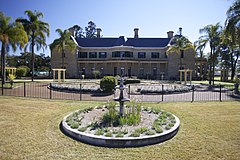Jimbour Station
| Jimbour | |
|---|---|

North facing view of Jimbour
|
|
| General information | |
| Type | Residential |
| Architectural style | French colonial |
| Location | Darling Downs |
| Address | 86 Jimbour Station Road, Jimbour |
| Coordinates | 26°57′40″S 151°14′06″E / 26.961131°S 151.235095°ECoordinates: 26°57′40″S 151°14′06″E / 26.961131°S 151.235095°E |
| Completed | 1877 |
| Renovated | 1923–1925 |
| Cost | £23,000 (1877) |
| Owner | Russell Pastoral Company |
| Technical details | |
| Structural system | Sandstone |
| Floor count | 2 |
| Floor area | 2,136 m² |
| Design and construction | |
| Architect | Richard George Suter and Annesley Wesley Voysey |
| Main contractor | Joshua Peter Bell |
Jimbour is a heritage-listed homestead on one of the earliest stations established on the Darling Downs, Queensland, Australia, It is important in demonstrating the pattern of early European exploration and pastoral settlement in Queensland, Australia. The building is associated with the development of the Darling Downs and of the pastoral industry in Queensland and is important in demonstrating the wealth and ambition of early Queensland pastoralists.
Jimbour House was an ambitious structure in terms of size, style and finish and was intended to support the social and political aspirations of Joshua Peter Bell, an important politician and businessman as well as grazier. It is unique in Queensland as the only genuinely grand country house in the English manner to be built in the state. Other substantial stone homesteads of the era, such as Talgai, Glengallan and Westbrook, came nowhere near to rivalling Jimbour in either size or opulence.
The property was first claimed by Henry Dennis on behalf of a Scotsman called Todd Scougall in 1842. Scougall established a run with sheep and cattle which were driven north from the Hunter Valley. Scougall experienced disease outbreaks and bankruptcy stemming from the collapse of the Bank of Australasia. The property was purchased by Thomas Bell for ₤3,200 in 1844. Bell was from Northern Ireland and had moved to Australia with his family in 1829.
In 1844, explorer Ludwig Leichhardt stayed at Jimbour, at that time the most northerly station on the Downs, preparing for his trip to Port Essington. In 1864, utilising their pre-emptive purchase rights, Thomas Bell, Joshua Peter Bell and John Alexander Bell acquired title to 4,786 acres (pre-emptive portion 1) of the Jimbour holding as tenants in common. This pre-emptive purchase included the head station site. Following Thomas Bell's death in September 1872, the Jimbour freehold was transmitted to Joshua Peter Bell, John Alexander Bell and a third brother, Marmaduke Bell, as tenants in common. The original house built by Scougall was burn down in 1867.
...
Wikipedia
